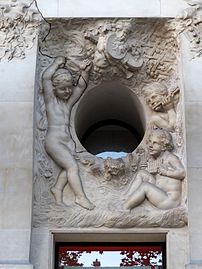| Hippolyte Lefèbvre | |
|---|---|
 | |
| Born | 4 February 1863 |
| Died | 22 September 1935 Arcueil |
| Alma mater | |
| Occupation | Sculptor, medalist, visual artist |
Hippolyte-Jules Lefèbvre (4 February 1863 - November 1935) was a French sculptor and medallist who received numerous official marks of recognition in his day but is now largely forgotten. His most prominent works are the monumental equestrian sculptures of Joan of Arc and Louis IX of France, set up on the Basilique du Sacré Cœur, Paris.
Biography
Lefèbvre was born on 4 February 1863, in Lille. From a working-class background, he made his first studies at the École des Beaux-Arts, Lille, where he won numerous prizes and was sent with a municipal scholarship to study at the École des beaux-arts, Paris. In 1882 he moved to Paris, where he was a pupil of Pierre-Jules Cavelier, Louis-Ernest Barrias and Jules Coutan. He began exhibiting regularly at the Salon des Artistes Français from 1887, and in 1892, after receiving seconds in 1888 and 1891, won the Grand Prix de Rome in sculpture; on his return to Paris he pursued a successful official career. He was made a chevalier of the Legion of Honour, and an officer in 1925.
Aside from Sacré-Coeur, where he also provided sculpture for the high altar, his public sculpture is to be seen also at the Grand Palais, Paris, where he received a gold medal at the Exposition Universelle (1900). His kneeling funeral figure of Léon-Adolphe Cardinal Amette, 1923, is in the Chapel of Saint-Vincent-de-Paul, Notre-Dame de Paris. He was called upon to provide sculpture for a number of monuments to the fallen of World War I. His Jeunes Aveugles (1902) won a medal of honor and was purchased for the collections at the Palais du Luxembourg, Paris.
His work may also be found on the Opéra de Lille, 1914; the Allegory of the Republic in the cour d'honneur of the French embassy in Vienna (built 1904); a marble Niobe at the Tour de Roland, Arles; and at the Hôtel de Ville, Roubaix.
Lefebvre was often called upon to make commemorative medals, such as one celebrating the centenary of Argentine independence, 1910; one commemorating Jules Gosset, for the Société des Sciences, Lille; one that the architect Louis M. Cordonnier, member of the Institut de France, distributed to friends and colleagues, 26 January 1912; Fondation Firmin Rainbeaux, 1930.
His workshop drawings and jottings, unlike his finished sculpture, approached abstraction.
Lefèbvre died in November 1935, in Arcueil.
Legacy
A street commemorates him in Lille and a quai in Mondeville.
Gallery
-
 Niobe (1897), Garden of Summer [d], Arles
Niobe (1897), Garden of Summer [d], Arles
-
 La Danse (1898), facade of the Hôtel Élysée Palace [fr], Paris, Champs-Élysées
La Danse (1898), facade of the Hôtel Élysée Palace [fr], Paris, Champs-Élysées
-
 The Elegant Lady with the Umbrella (1905), Pamiers
The Elegant Lady with the Umbrella (1905), Pamiers
-
 medallion of Louis Duchesne (1910), plaque
medallion of Louis Duchesne (1910), plaque
-
Funeral moument for Léon-Adolphe Amette (1923), Paris, crypt of the Basilica of Sacré-Cœur de Montmartre.
-
Equestrian statue of Joan of Arc (Basilica of Sacré-Cœur) [fr] (1927), Paris, Basilica of Sacré-Cœur de Montmartre
-
 Equestrian Statue of Louis IX [fr], (1827), 18th arrondissement of Paris
Equestrian Statue of Louis IX [fr], (1827), 18th arrondissement of Paris
-
 medal for the Lens Mining Company [fr] (1929)
medal for the Lens Mining Company [fr] (1929)
Notes
- American Numismatic Society (1911). "Hippolyte Lefebvre". Catalogue of the International Exhibition of Contemporary Medals: The American Numismatic Society, March, 1910. Introduction by Agnes Baldwin. pp. 182–186. OCLC 79900236 – via Internet Archive.
- "Ambassade de France à Vienne". ambafrance-at.org. 28 February 2006. Archived from the original on 9 July 2007.
- "Ville d'Histoire et de Patrimoine". patrimoine.ville-arles.fr. 18 July 2011. Archived from the original on 3 December 2006.
- Tuloup, Jean-Claude (September 2002). "Niobé" (PDF). Bulletin des Amis du Vieil Arles (in French). No. 116. Arles. pp. 4–7.
- "Roubaix 1911". Espace Ville Patrimoine la Condition Publique Roubaix. Retrieved 21 October 2024.
- "Hippolyte Lefebvre, bronze medal for the Centenary of Argentinian independance in 1810-1910". finemedals.com. 31 January 2004. Archived from the original on 18 November 2003. Retrieved 21 July 2024.
- "Hippolyte Lefebvre, bronze medal "Firmin Rimbeaux"". finemedals.com. 28 February 2005. Archived from the original on 15 January 2005.
- Venator, Michael (19 November 2004). "Hippolyte Lefebvre". Presentation Collection Michael Venator (in French). Retrieved 21 July 2024.
External links
- Hippolyte Lefèbvre in American public collections, on the French Sculpture Census website
